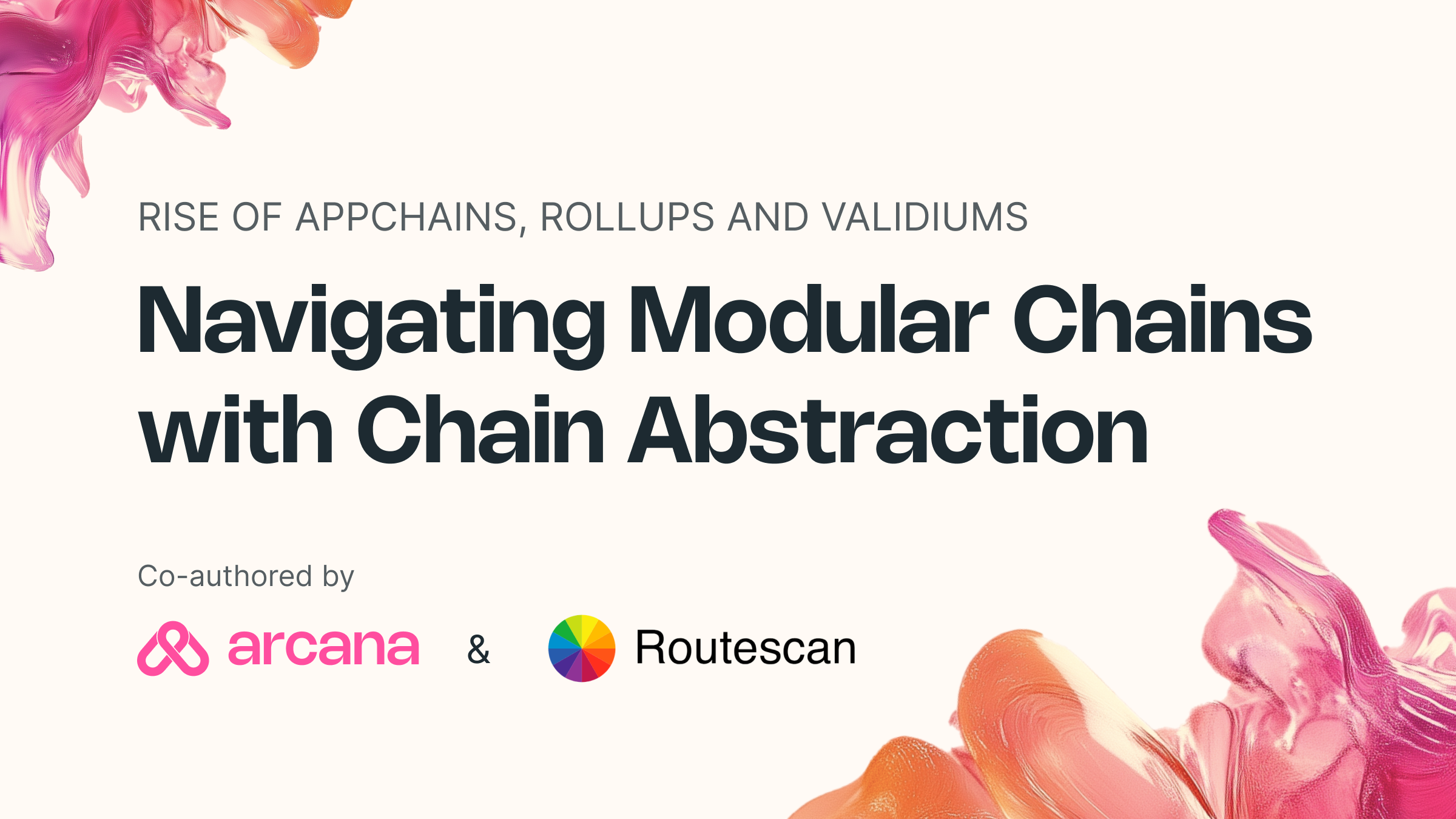Navigating Modular Chains with Chain Abstraction

The Evolution of Chain Abstraction: Beyond Blue Chip Assets
Every chain and app developer aims to solve the interoperability between blockchain and fragmentation of assets to:
- Make spending frictionless for users
- remove asset fragmentation and bridging
- Drive token utility through increased adoption across wider ecosystems.
Chain Abstraction is currently the leading solution for this seamless user experience. Phase 1 of solving the fragmented experience involved moving assets between chains. Phase 2 involves abstracting the underlying chains and balances across these chains, so users do not need to move these assets in the first place but instead see it as one unified experience with an aggregated balance.
Several key developments have accelerated this shift:
- Unified Liquidity Protocols: Advanced cross-chain solutions enable near-instantaneous transfers of major assets across blockchain networks.
- Standardized Bridging Mechanisms: Sophisticated bridges have reduced the technical complexity and financial risks of cross-chain transactions.
- User Experience Optimization: Wallets such as Arcana Wallet and decentralised applications increasingly abstract away the complexities of chain-hopping.
- Maturing Solver and Intent Networks with protocols like Across, Debridge, Arcana Network, etc., delivering seamless asset movements at scale.
Chain Abstraction protocols are standing out by capturing most of this order flow by abstracting the need for users to go to interop or bridging protocols in the first place. But soon, this experience will become the standard and hence erode the differentiation.
Solvers are readily willing to front millions in liquidity across major assets and chains due to their volume, lucrative fees, and capital efficiency in serving these chains and assets. The seamless movement of blue-chip and widely used assets—like ETH, USDC, USDT, and other stablecoins—across major chains such as Ethereum, Solana, Base, Arbitrum, etc., is rapidly becoming table stakes. Interoperability solutions, including bridges, layer-2 scaling, and cross-chain messaging protocols, have matured to meet the demands of liquidity for these assets and chains. This frictionless flow of high-liquidity assets will no longer be a niche experience but will evolve to be a common user expectation.
Exploring the Ecosystem of App Chains, Sovereign Rollups, and Validiums
The proliferation of appchains, sovereign rollups, and validiums has introduced a dynamic and fragmented ecosystem in the blockchain space. Each solution addresses specific scalability and customization needs, resulting in an explosion of native assets tied to these chains. Appchains, for example, cater to projects requiring dedicated environments, offering enhanced throughput, security, and tailored parameters to suit their unique use cases. Sovereign rollups and validiums, on the other hand, provide modularity and security guarantees by anchoring their operations to robust base layers like Ethereum, combining scalability with trust minimization.
While modular chains offer flexibility, they also introduce significant fragmentation—especially when each protocol defines its own standards for rollups, DA layers, and messaging. The native assets of these specialized chains often face liquidity constraints and interoperability challenges, as their niche applications limit broader adoption in the mainstream. Developers struggle to create applications that don't force users with steep learning curves when navigating between different protocols and blockchains.
The solutions to tackle this challenge introduce further fragmentation in experience due to opinionated design choices each ecosystem adopts and passing the design challenges that come with the various approaches over to the developer or end user. For example, choices made between optimistic rollups, data availability layers, cross-chain messaging protocols, chain development frameworks, execution environments, and interoperability protocols all impact the complexity and ease of solving the problem of making it easy for users and developers to build user-friendly apps.
Without a unified framework for interaction, these networks are isolated infrastructures with fragmented markets. A cohesive solution is needed to unlock the full potential of these modular technologies while simplifying the user experience.
Serving the Long Tail Assets and Chains
Apps are pivoting to appchains for valuation premiums and greater fee capture. Innovation in modularity and DA leading to an explosion of new rollups, adding to the already growing number of L1s, L2s, and L3s—all competing for users and liquidity. These chains and assets are largely still stuck solving for Phase 1 of fragmented experience while major chains and assets have the benefit of being served by protocols working on Phase 2 of unifying the experience for their users.
The long tail of tokens—native to app chains, sovereign rollups, and validiums—face a critical bottleneck: a lack of bridge support. These niche, purpose-built tokens, tied to ecosystems like AI agents or gaming platforms, struggle with liquidity and adoption due to economic and technical barriers.
For a bridge to support a new token or chain, several factors must align:
- Economic Viability: Bridges incur high operational and security costs, making low-volume chains or low-market-cap tokens unprofitable to support.
- Security: Adding a token requires extensive audits and risk assessments, which are often too costly for smaller projects.
- Technical Complexity: Each token’s custom integration requirement can force them to incur development costs that aren’t financially feasible.
Without bridge support, these tokens face compounding problems:
1. Liquidity Fragmentation: They remain siloed in their native ecosystems, unable to tap into broader chain and liquidity ecosystems.
2. Reduced Adoption: Users must navigate complex routes, like finding a DEX on the token’s native chain to swap and acquire them, deterring adoption.
3. Limited Interoperability: Cross-chain use cases become impractical, stifling utility. These lead to reduced adoption and growth, further delaying broader support from bridging and interop protocols
Examples of friction long tail assets and chains could face:
1) An AI agent built on Base blockchain wants users to pay for their service using their own custom token, deployed on Base. However, this token isn’t supported by bridges, meaning users would need to bridge supported assets to base and then swap to it on a decentralized exchange (DEX) on Base before they can use it, which complicates the experience.
2) A gaming platform is launching on its own appchain and plans to incorporate multichain functionality to allow players to wager with any asset they choose from other chains. This is because users are unlikely to bridge and swap and buy a game's native token on the appchain just to participate, but adding bridge support for their chain would be either too expensive or too time-consuming, limiting accessibility.
Chain Abstraction: Unlocking the Long Tail of Crypto Assets
Chain Abstraction (CA) emerges as a promising solution to the challenges posed by the long tail of crypto assets that aren’t popular but required for using specific chains and apps. By abstracting away the underlying complexities of interacting with multiple chains, Chain Abstraction enables users and developers to engage with blockchain ecosystems without needing to understand the intricacies of each layer. This abstraction can be achieved through cross-chain messaging protocols, unified wallets, or middleware that bridges disparate ecosystems, making it easier to transact and interact across chains.
Chain Abstraction protocols such as Arcana Network can enable users to spend specific long tail assets on long tail chains, whether they are an upcoming L1 or a niche appchain, through seamless and faster support.
This is by unifying the assets across chains and separating the intent from the execution:
1. Users and developers can express their intent to spend a specific token on a specific chain without worrying about the exact execution mechanism.
2. The execution is offloaded to the chain abstraction protocol and the specific appchains that want to enable a great user experience. Bypassing the economic viability, security, and other points of friction that arise in dealing with support from bridges, since the risk is offloaded to a different entity rather than the user.
3. The protocol standardizes the flow of liquidity from source chains to the destination chain through solvers and eliminates the friction of needing support from popular bridging or messaging protocols. The desired long-tail asset token is delivered on the destination chain by spending the tokens that the user does have.
4. Users can now spend a unified balance spread across multiple chains on their desired chain, in the token of their choice, or as required by the app.
Apps and chains see increased economic activity by allowing users to spend assets from appchains, sovereign rollups, and validiums without worrying about liquidity fragmentation or the technical hurdles of managing multiple wallets. For developers, Chain Abstraction opens new possibilities for creating interoperable applications that can tap into the value locked in niche or lesser-known assets. By unlocking the value of the long tail assets, Chain Abstraction fosters greater liquidity and utility across ecosystems, ensuring that even the most specialized assets can contribute to decentralized finance (DeFi), gaming, and other decentralized applications.
Chain Abstraction can facilitate a more user-friendly onboarding experience, helping to bridge the gap between mainstream adoption and the technical sophistication of blockchain ecosystems.
Embracing Chain Abstraction: The Future of Unified Blockchain Experiences
As blockchain technology matures, the complexities of interoperability, asset fragmentation, and user experience have become critical areas requiring robust solutions. Chain Abstraction represents the transformative step forward needed to unify fragmented ecosystems and unlock the full potential of modular chains, sovereign rollups, and validiums.
By enabling frictionless interactions across diverse blockchain ecosystems, Chain Abstraction not only simplifies user experiences but also empowers developers to innovate beyond existing limitations. Ultimately, adopting Chain Abstraction at scale will drive broader adoption and improve liquidity across the long tail of assets. The era of fragmented blockchain interactions is nearing its end, ushering in a future where unified experiences become the new standard.
To unlock the long tail of crypto, infra teams must invest in abstraction layers as public goods. Developers must design for cross-chain intent. And appchains must embrace interoperability not as a feature but as a foundation.

